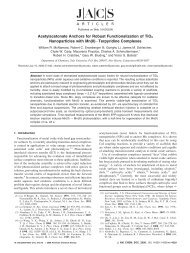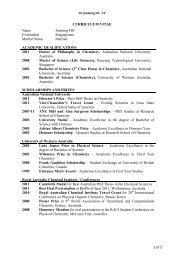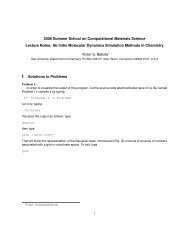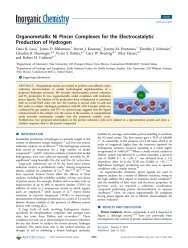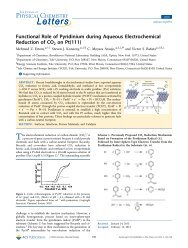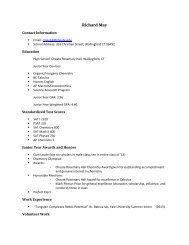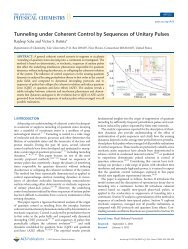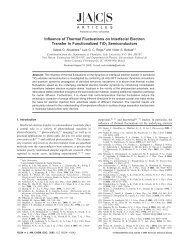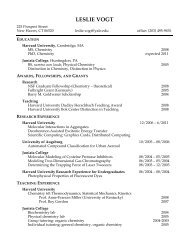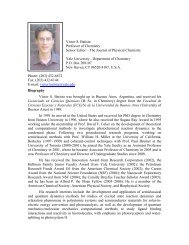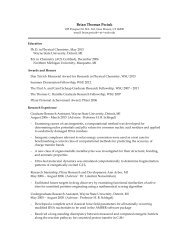Kepler PredictorâCorrector Algorithm - Yale Chemistry - Yale ...
Kepler PredictorâCorrector Algorithm - Yale Chemistry - Yale ...
Kepler PredictorâCorrector Algorithm - Yale Chemistry - Yale ...
You also want an ePaper? Increase the reach of your titles
YUMPU automatically turns print PDFs into web optimized ePapers that Google loves.
Journal of Chemical Theory and Computation<br />
(x(t), p(t)) are discussed in the following. Accordingly, the<br />
gradient will denote the vector of partial derivatives with respect<br />
to the relative coordinate x only:<br />
<br />
∇ 3 V ¼<br />
∂V , :::, ∂V<br />
∂x 1 ∂x 3<br />
<br />
ð14Þ<br />
The dependence of the phase-space relative coordinates<br />
(x(Δt), p(Δt)) on initial conditions (x(0), p(0)) is then<br />
approximated by<br />
xðt þ ΔtÞ ¼xðtÞ þ Δt<br />
m pðtÞ Δt 2<br />
2m ∇ 3Vj ðxðtÞ, ξðtÞÞ ð15Þ<br />
pðt þ ΔtÞ ¼pðtÞ<br />
Δt<br />
2 ð∇ 3Vj ðxðtÞ, ξðtÞÞ<br />
þ ∇ 3 Vj ðxðtþΔtÞ, ξðtþΔtÞÞ Þ<br />
ð16Þ<br />
To deal with the close encounter, the potential V is again<br />
written as a sum of the close encounter potential V s (r), r =||x||,<br />
and the residual potential V r (x, ξ):<br />
Vðx, ξÞ ¼V s ðrÞ þV r ðx, ξÞ<br />
ð17Þ<br />
and eqs 15 and 16 become<br />
xðt þ ΔtÞ ¼xðtÞ<br />
pðt þ ΔtÞ ¼pðtÞ<br />
þ Δt<br />
m pðtÞ Δt 2<br />
2m ð∇ 3V s j xðtÞ<br />
þ ∇ 3 V r j ðxðtÞ, ξðtÞÞ Þ<br />
Δt<br />
2 ð∇ 3V r j ðxðtÞ, ξðtÞÞ<br />
þ ∇ 3 V s j xðtÞ þ ∇ 3 V s j xðtþΔtÞ<br />
þ ∇ 3 V r j ðxðtþΔtÞ, ξðtþΔtÞÞ Þ<br />
ð18Þ<br />
ð19Þ<br />
Following section 2.1, we define appropriate auxiliary coordinates<br />
and momenta:<br />
x r ðt þ ΔtÞ ¼xðtÞ<br />
ð20Þ<br />
p r ðt þ ΔtÞ ¼pðtÞ<br />
x s ðt þ ΔtÞ ¼x r ðtÞ þ Δt<br />
m pr ðtÞ<br />
p s ðt þ ΔtÞ ¼p r ðtÞ<br />
and we obtain<br />
xðt þ ΔtÞ ¼x s ðt þ ΔtÞ<br />
Δt<br />
2 ∇ 3V r j ðxðtÞ, ξðtÞÞ ð21Þ<br />
Δt 2<br />
2m ∇ 3V s j x r ðtÞ<br />
ð22Þ<br />
Δt<br />
2 ð∇ 3V s j x r ðtÞ þ ∇ 3V s j x s ðtþΔtÞ Þ ð23Þ<br />
ð24Þ<br />
pðt þ ΔtÞ ¼p s Δt<br />
ðt þ ΔtÞ<br />
2 ∇ 3V r j ðxðtþΔtÞ, ξðtþΔtÞÞ ð25Þ<br />
During a close encounter, eqs 22 and 23 are replaced by the<br />
analytic solution of the <strong>Kepler</strong> problem, as described in section<br />
2.3, and the resulting values are then augmented according to<br />
ARTICLE<br />
eqs 24 and 25. The resulting algorithm for multibody molecular<br />
dynamics is summarized, as follows:<br />
1. Determine p r (t) by momentum shift according to eq 21.<br />
2. Compute (x s (t + Δt), p s (t + Δt)) by solving the <strong>Kepler</strong><br />
problem S K :<br />
ðx s ðt þ ΔtÞ, p s ðt þ ΔtÞÞ ⊂ S K ðxðtÞ, pðtÞÞ<br />
ð26Þ<br />
3. Obtain coordinates x(t + Δt) and ξ(t + Δt), as follows:<br />
a. From x s (t + Δt), determine x(t + Δt) according to eq 24.<br />
b. Obtain ξ(t + Δt) by using velocity Verlet, or otherwise<br />
solving steps 2 and 3a for relative coordinates describing<br />
two-body close encounters.<br />
4. Obtain momenta p(t + Δt) and p(t + Δt), as follows:<br />
a. From p s (t + Δt), determine p(t + Δt) according to eq 25.<br />
b. Determine π (t + Δt), analogously to step 3b.<br />
2.3. <strong>Kepler</strong> Problem. When a close encounter is detected, we<br />
consider the particle attracted by the nearest singularity:<br />
V s γ<br />
ðrÞ ¼<br />
ð27Þ<br />
r<br />
where<br />
rðtÞ ¼x s ðtÞ X ð28Þ<br />
with X being the position of the singularity. We solve the<br />
equation of motion:<br />
€r þ μ r<br />
r 3 ¼ 0<br />
ð29Þ<br />
with force parameter μ = γ/m resulting from the gravitational or<br />
Coulomb coefficient γ and the mass m, and initial conditions r 0 =<br />
x(t) X and v 0 = _x(t). The solutions exploit the conservation of<br />
specific angular momentum L = r v, specific energy h s (t) =<br />
v 2 /2 μ/r, and eccentricity vector e = v (r v)/μ r/r.<br />
Equation 29 is regularized by introducing the fictitious time<br />
τ with<br />
d<br />
dτ ¼ r d ð30Þ<br />
dt<br />
leading to the regularized equation of motion<br />
r 00 2h s r ¼ μe ð31Þ<br />
where the derivatives in eq 31 are in respect to τ, and the initial<br />
conditions are modified according to eq 30 to r(τ =0)=r 0 and<br />
r 0 (τ =0)=rv 0 . This is a harmonic oscillator problem that is<br />
readily solved by exponential functions, typically leading to real<br />
solutions that are trigonometric or hyperbolic functions.<br />
The motion is characterized according to four classes of<br />
possible solutions, including circular, parabolic, elliptic, and<br />
hyperbolic, as shown in the following subsections. 36 [In<br />
contrast, ref 36 considers 13 classes of solutions, including<br />
the circular case and 12 other cases generated from the<br />
elliptic, hyperbolic, and parabolic classes as subdivided according<br />
to the values of the rotational momentum and<br />
fictitious time τ, described below.] The circular and parabolic<br />
cases have simple, explicit solutions, while the elliptic and<br />
hyperbolic cases lead to <strong>Kepler</strong> equations that need to be<br />
solved iteratively. 37,38<br />
2.3.1. Circular Motion. When r 0 3 v 0 = 0, the eccentricity e =0<br />
and eq 31 becomes homogeneous. In this case, r 0 3 v 0 = 0 and<br />
v 0 =(μ/r 0 ) 1/2 ; i.e., the coordinate change is orthogonal to the<br />
27 dx.doi.org/10.1021/ct200452h |J. Chem. Theory Comput. 2012, 8, 24–35



